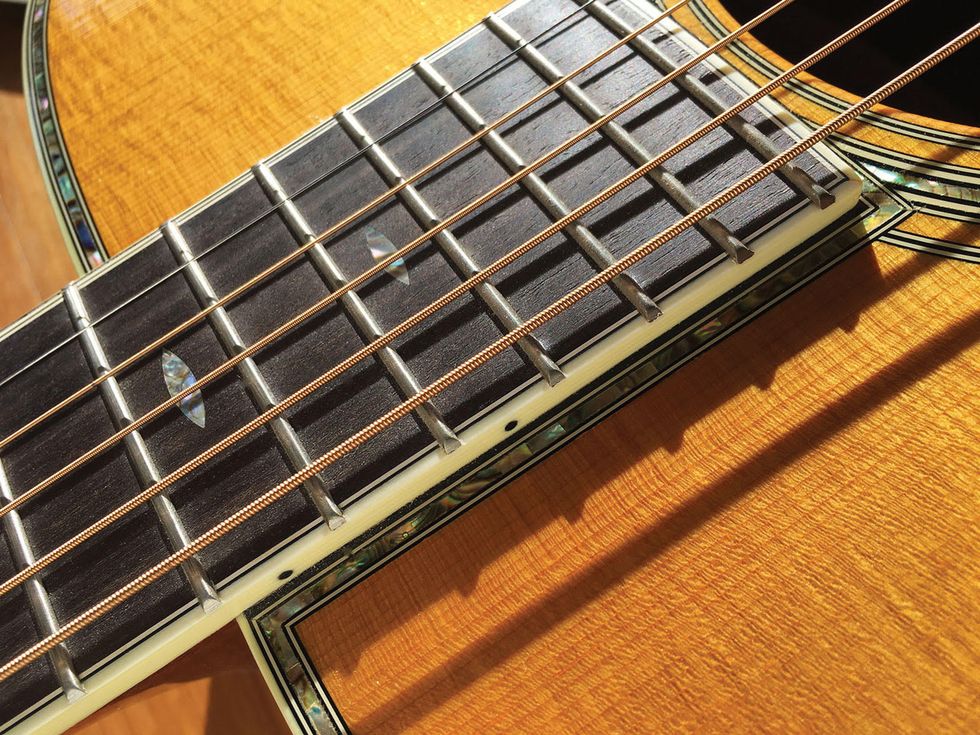More than any other part of your guitar, the fretboard is where the magic happens. When you pick up a guitar, the neck and fretboard give you the first indication if you’re going to make beautiful music together. There are a lot of things that go into the feel of the neck—and I’ve covered a few of them in previous columns—but right now we’re going to drill down on just the edge of the fretboard.
As you slide up and down the neck, you feel that edge whether you’re playing chords or spitting out single-note runs. Contact with the treble side of the fretboard is a given, and many of us hook our thumb over the bass side to mute and finger low notes, so it follows that special attention should be paid to this area of the instrument.
Bound or unbound. The art of laminating ornamental strips of material at the fretboard edge dates back at least to 2,000 BC. It’s been found on ancient tanburs from Mesopotamia and other parts of Asia. Why these early stringed instruments were adorned with bindings is not exactly known, but we can guess it’s for the same reasons as today. Bound necks can certainly look cool, but there’s also a practical reason: comfort.
Fretboard wood exposed to low humidity shrinks, exposing the metal fret ends. This can be distracting, at best, and painful, at worst. Most guitar makers are careful to control humidity year round, usually choosing a safe middle ground. Still, instruments are shipped to destinations that vary considerably, and that’s when the trouble begins. If an instrument’s new home is more humid than the builder’s shop, the frets aren’t going to suffer. But if the air is dry, the fret ends can be a problem. The condition is remedied by filing the fret ends again while the fretboard is at low tide, so to speak. When the humidity rises, you’re still covered.
To nib or not to nib. Binding that covers the fret ends—as found on many Gibson guitars—can help reduce the sharp-edge effect. The so-called “nibs” that cover the fret ends guard you from sharp metal edges, and look cool, too. Creating the covered frets, however, is a labor-intensive process that requires the binding strip to be applied after the frets are filed flush with the fretboard edge. The binding is tall enough to cover the end of the frets, but must be cut down between the frets to be even with the fretboard. This is usually done with a router bit and finished by hand with small files. The nibs do make refretting more difficult, because the frets must be cut to exact length before they are inserted into the slots. Most repair shops don’t have a problem doing this, but be aware they may charge a little more for the extra time it takes.
Skip the nib. Some designs avoid the nibs by allowing the frets to go over the binding, where they are beveled, as on an unbound neck. The fret tang is removed underneath the fret at each end, which is just as laborious as the nib method. The advantage is that the frets are as wide as the neck. Martin has been doing it this way forever, and many other builders, including Fender, do as well. These necks feel pretty much the same as unbound ones, so it’s mostly for aesthetics. This method also takes a little more effort to refret, because the fret tang must be precisely cut.
Rolling with it. Another type of fretboard treatment is the rolled edge. This is when the builder rounds off the top edge of the fretboard to avoid it being sharp. There are numerous ways to do it, but methods generally fall into two camps. The first is simply sanding and/or filing the edge of the fretboard between the frets after the neck is completed. The resulting feel is reminiscent of the natural wear found on well-played, older guitars. The second method involves machining a radius on the fretboard’s edge, and is more extreme than the first technique. It can, however, be done either before or after the frets are installed.
The final choice Whether or not you like the look of binding on the neck, realize that it can change the way your instrument feels. The good news is that there are various treatments that can change the feel of any fretboard edge. You can have a repair shop roll the edges of your guitar’s fretboard—even if it has binding—so if you like the look, you don’t have to compromise. Also, know that sharp fret ends aren’t a deal-breaker if you really love a guitar. Just remember to have any sharpness removed when the humidity is low, and you’ll probably never have to deal with it again.








![Rig Rundown: Russian Circles’ Mike Sullivan [2025]](https://www.premierguitar.com/media-library/youtube.jpg?id=62303631&width=1245&height=700&quality=70&coordinates=0%2C0%2C0%2C0)

















